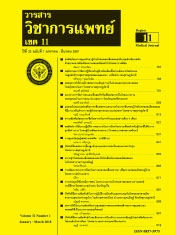พฤติกรรมการใช้ยาปฏิชีวนะในผู้ป่วยโรคติดเชื้อทางเดินหายใจส่วนบนในศูนย์บริการ สุขภาพชุมชนตลาดดอนนก เครือข่าย รพ.สุราษฎร์ธานี
บทคัดย่อ
การวิจัยเชิงพรรณนาครั้งนี้ มีวัตถุประสงค์เพื่อศึกษาพฤติกรรมการใช้ยาปฏิชีวนะของผู้ป่วยโรคติดเชื้อทาง เดนิหายใจสว่นบนและปจัจยัทม่ีผีลตอ่พฤตกิรรมการใชย้าปฏชิวีนะของผปู้ว่ยโรคตดิเชอ้ืทางเดนิหายใจสว่นบน กลมุ่ ตวัอยา่ง คอื ผปู้ว่ยโรคตดิเชอื้ทางเดนิหายใจสว่นบนทมี่าใชบ้รกิารทศี่นูยส์ขุภาพดอนนก เครอื่งมอืทใี่ชใ้นการรวบรวม ข้อมูลครั้งนี้ใช้แบบสอบถามซึ่งประกอบด้วยข้อมูล 4 ส่วนคือ ข้อมูลส่วนบุคคล การวัดความรู้ในการใช้ยาปฏิชีวนะ การวดัทศันคตใินการใชย้าปฏชิวีนะ และ การวดัพฤตกิรรมหรอืการปฏบิตัติวัในการใชย้าปฏชิวีนะ ซงึ่ผา่นการทดสอบ ความตรงเชิงเนื้อหาจากผู้เชี่ยวชาญ และ ทดสอบความเชื่อมั่นโดยวิธีอัลฟาของครอน-บาค ด้านความรู้ ทัศนคติ และ พฤติกรรม มีค่าเท่ากับ 0.698 ,0.71 และ 0.689 เก็บข้อมูลโดยการให้กลุ่มตัวอย่างตอบแบบสอบถามระหว่างวันที่ 14 กรกฎาคม 2560 – 30 สิงหาคม 2560 วิเคราะห์ข้อมูลโดยใช้สถิติพรรณนา ได้แก่ จำานวน ร้อยละ ค่าเฉลี่ย ส่วน เบี่ยงเบนมาตรฐาน และ สถิติอนุมาน ได้แก่ Independent t test, one way ANOVA และ Correlation ผลการวิจัยพบว่า กลุ่มตัวอย่างมีความรู้เรื่องการใช้ยาปฏิชีวนะอยู่ในระดับต่ำา ร้อยละ49.2 ระดับปานกลาง ร้อยละ 38.3 และ ระดับความรู้สูงเพียง ร้อยละ 12.5 ผลการศึกษาภาพรวมของระดับทัศนคติอยู่ในระดับปานกลาง ส่วนระดับพฤติกรรมในการใช้ยาปฏิชีวนะอยู่ในระดับดี เมื่อเปรียบเทียบพฤติกรรมการใช้ยาปฏิชีวนะ พบว่า ระดับ การศกึษาและการไดร้บัคำาแนะนำา มผีลตอ่พฤตกิรรมการใชย้าปฏชิวีนะอยา่งมนียัสำาคญัทางสถติ ิ (p<.05) และ พบ วา่ความรมู้คีวามสมัพนัธเ์ชงิบวกกบัระดบัพฤตกิรรมการปฏบิตัติวัเกยี่วกบัการใชย้าปฏชิวีนะอยา่งมนียัสำาคญั (p<.05) ส่วนทัศนคติไม่มีความสัมพันธ์กับระดับพฤติกรรมการปฏิบัติตัวเกี่ยวกับการใช้ยาปฏิชีวนะ จากการศึกษาระดับความรู้การใช้ยาปฏิชีวนะในกลุ่มตัวอย่างพบความระดับความรู้อยู่ในระดับปานกลาง ถึงต่ำา ร้อยละ 87.5 และ ความรู้เกี่ยวกับการใช้ยาปฏิชีวนะมีความสัมพันธ์เชิงบวกกับพฤติกรรมเกี่ยวกับการใช้ยา ปฏชิวีนะ ผวู้จิยัมคีวามเหน็วา่ควรมแีนวทางการใหค้วามรเู้รอื่งการใชย้าปฏชิวีนะแกป่ระชาชนโดยเนน้ในกลมุ่ทมี่กีาร ศึกษาต่ำากว่าปริญญาตรีและกลุ่มที่ไม่เคยได้รับคำาแนะนำาจากบุคลากรทางสาธารณสุขเพื่อช่วยลดพฤติกรรมการใช้ ยาที่ไม่ถูกต้อง
เอกสารอ้างอิง
Shehadeh Mayadah. Knowledge, attitudes and behavior regarding antibiotics use and misuse among adults in the community of Jordan.A pilot study.Jordan: Saudi Pharmaceutical Journal; 2012; 20:125–133
วสาวี กลิ่นขจร. พฤติกรรมการใช้ยา ปฏิชีวนะของผู้รับบริการในโรงพยาบาลส่งเสริมสุขภาพ ศูนย์อนามัยที่ 3. (ออนไลน์ ). 2554. แหล่งที่มา:http://203.157.71.125/vijai/tong1.20454.pdf. (สืบค้น เมื่อ 25 เมษายน 2560).
ศูนย์เฝ้าระวังการดื้อยาต้านจุลชีพแห่งชาติ. สถานการณเ์ชอื้ดอื้ยาปฏชิวีนะในไทย.(ออนไลน)์. 2558. แหล่งที่มา :http://narst.dmsc.moph.go.th/news001. html. (สืบค้นเมื่อ 25 เมษายน 2560).
จิรชัย มงคลชัยภักดิ์ .การศึกษาความรู้และ พฤติกรรมเกี่ยวกับการใช้ยาปฏิชีวนะของผู้รับบริการ ในร้านยาชุมชนจังหวัดปทุมธานี. วารสารวิชาการ มหาวิทยาลัยอีสเทิร์นเอเชีย.2555; 6(2) : 91-100.
คณะแพทยศาสตร์โรงพยาบาลรามาธิบดี. แนวทางปฏิบัติในการดูแลผู้ป่วยโรคติดเชื้อระบบทาง เดินหายใจส่วนบน.(ออนไลน์).2558 แหล่งที่มา: http:// med.mahidol.ac.th/ramapharmacy. (สืบค้นเมื่อ 25 เมษายน 2560).
ศุภลักษณ์ สุขไพบูลย์ .2559. พฤติกรรม การใช้ยาปฏิชีวนะของผู้รับบริการโรงพยาบาลส่งเสริม สุขภาพตำาบลสร่างโศก อำาเภอบ้านหมอ จังหวัดสระบุรี. (ออนไลน์).2559 แหล่งที่มา:http://journal.nmc.ac.th/ th/admin/Journal/2559Vol4No1_53.pdf. (สืบค้นเมื่อ 25 เมษายน 2560).
Becker, M. H.The health belief model and personal health behavior. Health Education Monographs.1974; 2 : 324-473.






